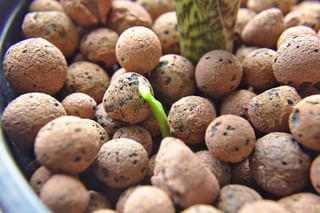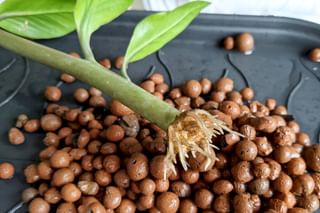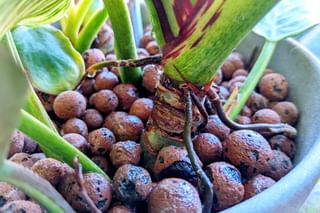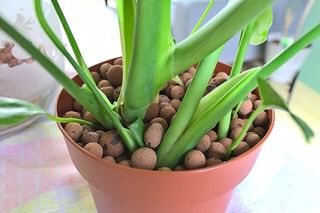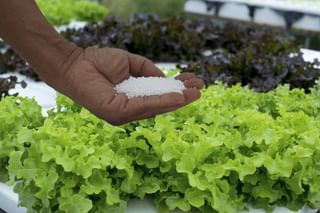Which plants can you grow in Leca?
Leca is a very versatile growing medium for your houseplants, but whether or not you can grow your favorite houseplant in Leca depends on a few things. In this post, we're going to find out which plants work well with Leca and which ones might not do too well with it.
Leca (Lightweight expanded clay aggregate) has its advantages and disadvantages like any other growing medium.
But even when you know what Leca means and how you can use it, you might still need to ask yourself: "Can my plant grow in Leca?".
In this post, we're going to find out which plants work well with Leca and which ones might not do too well with it. Here are the topics we're going to cover:
It's difficult to list every single plant that will do well with Leca, so let's list some characteristics of plants that do well in Leca instead. When you use this list, you can compare it to your plant and see if it'll do well in Leca or if you need to look for something else.
What is Leca and why is it suitable for certain plants?

Before we get into which plants will do well in Leca, you may be wondering what Leca is. Leca is a lightweight, porous material made of expanded clay pellets that is growing in popularity among plant enthusiasts. This growing medium is particularly useful for plants that require good drainage, such as succulents and cacti, as it helps prevent waterlogging.
One of the benefits of Leca is its ability to provide good aeration to plant roots, allowing them to breathe and absorb nutrients more efficiently. We will get into nutrients more in a later section, but it's important to note that although Leca helps plants absorb nutrients, it does not provide the nutrients itself, you'll need to add it.
Leca also helps prevent root rot, which is a common problem in plants grown in dense soil. Leca is reusable, making it a more sustainable option than traditional soil-based growing media. It can be washed, sterilized, and used again for multiple plantings.
Leca also does not attract pests or mold, making it a low-maintenance option for plant owners. It does not decompose over time, making sure that it can provide long-term support to your plants.
Examples of plants that do well in Leca
The following are not all specific plants but rather plant families. If you have a plant within one of the plant families that you can see here, it should do well in Leca. This is not a complete list, but these are the plants I've personally had success with growing in Leca.
Monstera
Monstera plants are one of the most low-maintenance plants out there, making them an ideal choice for those who are just starting to delve into the world of plant care. When used as a growing medium for Monstera plants, Leca provides optimal drainage and aeration, allowing the roots to breathe and grow without being suffocated by soil. Since Monstera plants are susceptible to overwatering, Leca will help you avoid this common problem.
Sansevieria
Sansevieria plants, commonly known as snake plants, are known to be plants that thrive in dry environments. They're generally quite easy to take care of, but it could be easier. Growing Sansevieria plants in Leca is a great way to take care of these plants with even more ease and efficiency. Sansevieria plants need excellent drainage, making them a perfect plant for Leca.
If the snake plant requires more water, it will grow its roots towards the bottom of the pot, where excess water stays behind. Leca makes sure the plant doesn't get overwatered, which is one of the most common mistakes with these drought-loving plants in soil.
ZZ Plant
The ZZ plant is another houseplant that prefers a drier environment. With the help of Leca, your ZZ plant won't get overwatered. The ZZ plant stores a lot of moisture in its thick stems, so it won't need to be watered very often. By using Leca for your ZZ plant, you'll avoid overwatering the ZZ plant as most water will instantly drain to the bottom of the pot. The Leca will slowly absorb the water at the bottom of the pot and distribute it upwards.
Like a Sansevieria, if the ZZ plant won't get the moisture it needs, it'll grow roots towards the water sitting at the bottom of the pot to absorb the needed moisture.
Alocasia
Most Alocasias are plants that actually like the soil to be moist most of the time. They're tropical plants. So why does Leca still work for these plants? Because the plant is also quite sensitive to root rot and has very quickly growing roots. Its roots are very fleshy and soft, so if it were to grow in soil that's too wet, it'll start to rot fairly quickly. Leca helps to prevent this by draining the water to the bottom of the pot and providing an excellent flow of oxygen.
Spider plant
Another plant that does quite well in Leca is the Spider plant. I'm not sure why it works so well because this plant thrives in a moist environment and needs quite a bit of moisture to stay healthy.
I've been able to keep this plant happy in Leca by basically drowning it. Normally, when you water your plant in Leca, you want a small layer of water at the bottom of your pot. This layer of water must stay below the biggest part of the roots of your plants because this helps to prevent root rot.
Watering a spider plant in Leca is a little different. Because these plants love moisture, I make sure the water level is about halfway up the pot. This means that most of the roots of this plant are underwater.
A spider plant absorbs and uses this water quite quickly, but this has another benefit: it makes the moisture-loving spider plant low-maintenance. In soil, you can't water your plant like that, because it'll cause root rot, but Leca doesn't rot, so it can handle being underwater for quite a while.
Begonia
Much like the spider plant, the Begonia plant family also likes to grow in soil that is moist most of the time. Because of this, you can water your Begonia like you would a Spider plant and it'll be happy.
Characteristics of plants that do well in Leca
In this section, we look into the specific traits and characteristics of plants that thrive in Leca. Understanding these characteristics will make it easier for you to identify other potential plants that could be a good fit for Leca, beyond the ones we've already discussed.
Plants that like to dry out before watering
If your plant likes to dry out before watering, it might be a good candidate to grow in Leca. Leca is great for regulating water throughout the pot, but it doesn't soak up water throughout the whole clay ball. The fact that it doesn't soak up water, to be equal to or more than its weight, means it's not able to give some moisture-loving plants the moisture level they'd like. The clay balls only soak up around 30% of their weight, which is great for more plants that like to dry out.
Plants that can grow a large root system quickly

Plants that grow a root system quickly are the most likely to succeed in Leca. These types of plants usually spread their root system to look for moisture to absorb, which they'll easily be able to find in the clay balls. Unlike soil, which holds onto moisture, Leca soaks up all the moisture it can hold and lets the excess water sink to the bottom of the pot. When your plant has absorbed all the moisture that the clay balls have soaked up, it'll have to get moisture from different places.
If your plant is really thirsty, like a spider plant, it'll grow roots everywhere to absorb as much moisture as possible. However, if your plant loves to be dry, it won't spread out as much and it'll wait for the Leca to soak up more water to absorb. Slower growing plants can still grow in Leca, but they will have much less control over the amount of moisture they can absorb.
If you have a slower-growing plant that also loves to be dry, waiting for the Leca to soak up more water again is no problem at all. These plants love the drought and they thrive in it, like Sansevierias.
Plants that don't mind being handled every once in a while
When you're first converting your plant from soil to hydroponics, you have to clean your roots to get rid of any soil. It's very difficult to get this right on the first try, so you'll likely have to clean your plant again after planting it in Leca. After you've planted your plant in Leca, you can easily take it back out of the pot and check the roots, because the clean balls are loose around the roots.
A month after you've first planted your plant in Leca, you'll have to clean the clay balls and the roots. Your plant needs to be able to handle this and not go into shock straight away. Some plants, like Calatheas, don't like to be handled too often, so be sure to check if your plant can handle this.
Plants that like to be in oxygen-rich soil
As all hydroponics growing mediums have excellent drainage and have lots of space in between individual balls/rocks, they provide a lot of oxygen to your plant's roots. Some plants love to be in moist soil all the time and have developed roots that can survive in this environment.
These roots generally don't get a lot of oxygen to their roots, as the moist soil doesn't breathe as much as dry soil. If you have a plant that loves to be in moist, compact soil, it might not be the right plant for hydroponics. However, if your plant likes dry and/or porous soil, it will love hydroponic growing mediums including Leca.
Plants that don't rely on soil to provide it with nutrients
Hydroponics growing mediums are not live growing mediums and can't provide your plant with nutrients by themselves. To feed your plants, you'll need to use hydroponics fertilizer. You add this fertilizer to the water that you will use for your plants. When your plant absorbs the moisture and fertilizer it should be able to store these in its stems and/or leaves, because most hydroponics growing mediums can't hold on to the fertilizer too well.
The plants that have the best chance to do well in Leca can live off the nutrients it stores in its stems and don't rely on the growing medium to provide them with nutrients. Some plants absorb most of the nutrients they need to grow directly from the soil and these plants won't do well in Leca.
However, there are other growing mediums, like Vermiculite and Pumice, that can hold onto fertilizer to help your plant grow. Vermiculite and Pumice might be a better option if you still want to use a soil-less growing medium.
How do you choose the right plants for growing in Leca?
When it comes to choosing the right plants for growing in Leca, there are a few important factors to consider. As someone who has dealt with the frustrations of killing plants by accident and being overwhelmed by conflicting information, I understand the challenges that come with plant care. But lucky for you, there are practical solutions to these common problems.
In addition to the earlier sections, there are a few more tips for considering which plants to put in Leca. It's important to choose plants that are suitable for Leca growing. This means selecting plants that don't mind having their roots exposed to air and can tolerate drier conditions. Some great options include succulents, cacti, and some tropical plants like pothos and snake plants.
Another factor to consider is the size of your plant. If you're new to Leca growing, it may be a good idea to start with smaller plants that are easier to manage. As you gain experience and confidence, you can gradually move on to larger plants.
Do plants in Leca need any extra care compared to those in soil?
When it comes to caring for plants, many people wonder if there are any special considerations when planting in Leca compared to soil. The truth is that while planting in Leca can have many benefits, it does need extra care to make sure that your plants thrive.
One of the biggest benefits of planting in Leca is that it provides excellent drainage and aeration, which can help prevent overwatering and root rot. However, because Leca is a highly porous material, it'll dry out more quickly, leaving some of your plants thirsty. This is why plants that like to dry out are ideal candidates for growing in soil.
A challenge, or rather adjustment when planting in Leca is that you will need to fertilize your plants more often than you would with plants in soil. This is because Leca doesn't provide any nutrients to your plant as the soil does, so you'll need to use special hydroponic fertilizer when you water your plants to keep them healthy.
Can Leca be used for both indoor and outdoor plants?
The most common use for Leca is in greenhouses for vegetables. These growing beds are flooded and then dry out, so the herbs and vegetables are never too wet or too dry.
I've primarily used Leca for houseplants, but that doesn't mean it can only be used indoors. After all, Leca is just a growing medium, like soil. Because Leca, like soil, is just a growing medium for plants, you can use it indoors and outdoors.
When you want to use Leca outdoors, there are 2 things to keep in mind. The first is rain. Leca works best if it can absorb water from the pot. This means that you need to use a pot without a drainage hole. If you grow a plant in a pot like this outdoors and it rains a lot, soon the whole pot will be full of water and you're drowning your plant. Move them under a roof or choose a pot with a few smaller drainage holes if you live in an area that gets a lot of rain.
The other thing to think about is pot placement. Leca works well because it doesn't contain any living organisms. This prevents root rot and fungal infections. If you place your pot with leca near larger plants or trees, you invite organic material from these plants to fall into the pot and start to rot. This kind of defeats the purpose of Leca, so if this is the only space you've got you might want to use soil instead.
Can Leca be reused for multiple plantings or should it be replaced each time?
You may be wondering whether Leca can be reused for multiple plantings or whether it should be replaced each time. The good news is that Leca is a long-lasting growing medium that can be reused for multiple plantings, making it a cost-effective option for growing your plants.
Leca is a porous and lightweight material that doesn't break down over time, so it can be reused indefinitely as long as it is properly cleaned and sterilized between plantings to prevent the spread of disease and pests.
To reuse Leca, simply remove the old plants and gently rinse the clay pebbles with water to remove any debris or leftover plant material. Then, sterilize the Leca by soaking it in a solution of one part hydrogen peroxide to ten parts water for 24 hours. Rinse the Leca thoroughly with clean water and it's ready to be used again for your next planting.
If you don't want to use any chemicals, you can also let it soak in boiling water. This will also kill any harmful creatures and pests in the growing medium.
Conclusion
Leca is a very versatile growing medium for your houseplants, but whether or not you can grow your favorite houseplant in Leca depends on a few things. Its porous nature allows for excellent drainage and aeration, making it an ideal choice for plants that prefer drying out between waterings. The ability to reuse Leca makes it not only cost-effective but also environmentally friendly.
However, it is important to remember that growing plants in Leca is not a one-size-fits-all solution. Your houseplant should be a plant that likes to dry out between waterings, it should be able to quickly grow its root system, it should be fine with being handled (and not go into shock), it should like plenty of oxygen to reach its roots, and lastly, it should be able to store nutrients without relying on the growing medium to provide it with nutrients all the time. It's always essential to research your specific plants and understand their unique needs.
Although Leca may present a learning curve, especially to new plant owners, the resulting healthy, vibrant plants are worth the effort. Remember, successful plant care is a journey of learning and experimentation, so don't be afraid to give Leca a try! If your favorite plant checks all of these marks, Leca is a great growing medium for it.
Thank you for reading this post! I hope it helps you to keep your plants healthy and beautiful! If you're looking for more guides on specific plants, you can always request a plant guide to get a guide for the plant you have trouble with.
Test your plant care knowledge
Quiz completed!
Want to learn more? Sign up for my newsletter to receive free tips in your inbox!
Sign up now!